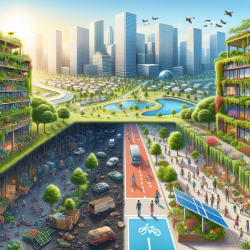The concept of biophilic urban planning has been a beacon for many urban communities looking to integrate nature into their environments. However, recent research suggests that simply implementing green infrastructure (GI) is not enough to address deeper issues in environmental justice communities. The study titled “Green Enough Ain’t Good Enough” delves into public perceptions and emotions related to green infrastructure in such communities, offering valuable insights for practitioners.
The Importance of Understanding Public Perceptions
The research conducted in Waterfront South, Camden, NJ, highlights that while residents recognize the benefits of green stormwater infrastructure (GSI), they also express concerns about its implementation. Practitioners must understand that public perceptions are shaped by more than just the visible benefits of GSI. Residents value social benefits like beautification and community space creation more than indirect environmental benefits.
Key Takeaways for Practitioners:
- Engage with the Community: Effective GSI planning requires active community engagement. Understanding local needs and perceptions can help tailor projects that truly benefit residents.
- Avoid One-Size-Fits-All Solutions: Each community is unique. Practitioners should avoid cookie-cutter designs and instead focus on context-sensitive solutions that address specific local challenges.
- Focus on Maintenance: Proper maintenance is crucial. Neglected GSI projects can become eyesores and negatively impact community perceptions.
The Role of Emotional Attachments
The study also emphasizes the emotional connections residents have with their environment. Positive emotional attachments can enhance the perceived value of GSI projects, while negative experiences can undermine them. Practitioners should consider these emotional aspects when designing and implementing projects.
Strategies to Enhance Emotional Connections:
- Create Dual-Purpose Spaces: Design GSI projects that serve both environmental and social functions, such as incorporating seating areas or art installations.
- Educate and Inform: Use signage and community workshops to educate residents about the benefits and maintenance of GSI projects.
A Call for Further Research
This research underscores the need for further exploration into how GSI impacts human health and well-being in EJ communities. Practitioners are encouraged to delve deeper into these issues to better align their efforts with community needs.










